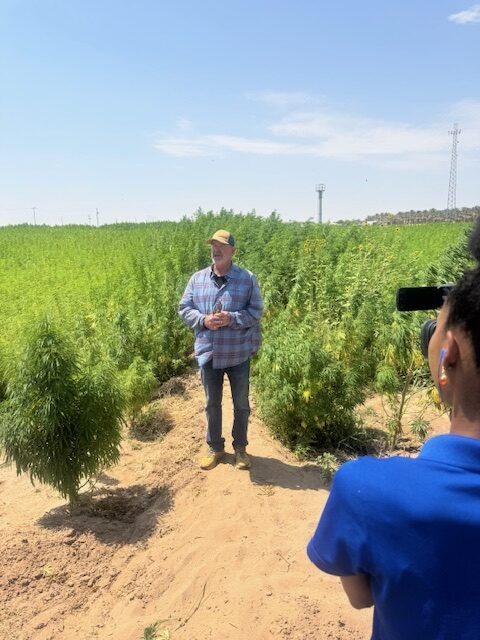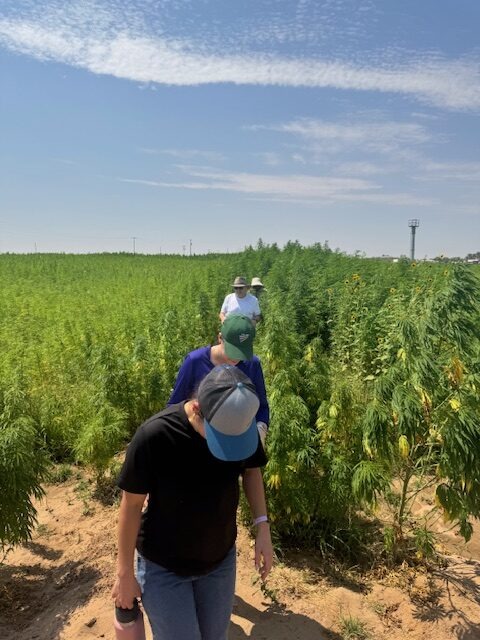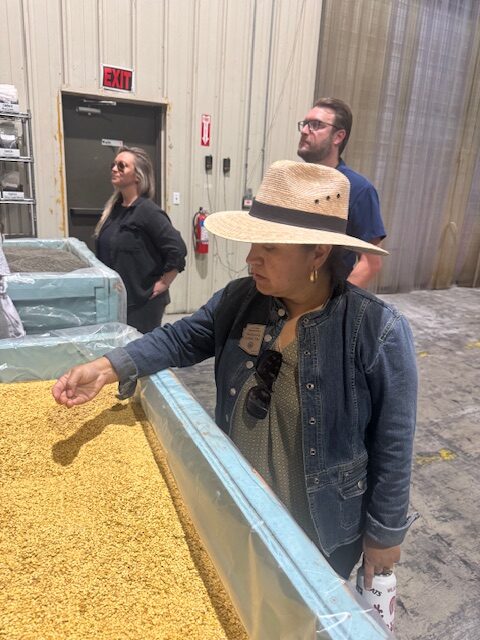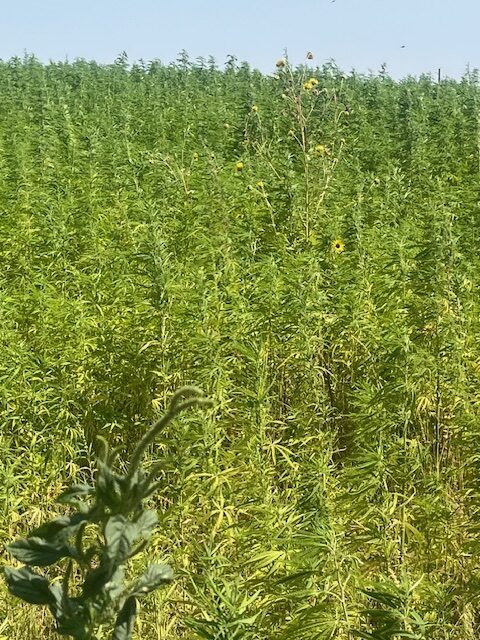YUMA, Ariz. — Hemp stalks soared into the desert sky, swaying with each hot gust of wind. Walking between the rows felt like entering another era—no walls, no buzzing lights, just land, scorching sun, and green stalks stretching tall and proud.
The plants grew thick and wild, turning dry fields into narrow green corridors. Sunlight filtered through leaves as trail wound deeper into the lush canopy. Weeds and desert wildflowers tangled beneath each step, brushing against boots and ankles. The dense foliage cooled the air and trapped moisture, transforming a once-barren landscape into a living, breathing hemp oasis.

Last week, the Hemp Industry Trade Association (HITA) brought that vision to life for a dozen of visitors during its field tour in Yuma. Farmers, scientists, builders, and advocates walked the rows together, guided by Daniel Nowell of American Hemp Supply Co. and HITA organizers. They came to see what hemp could offer the Southwest—and they didn’t leave disappointed.
Hemp once stood at the heart of American agriculture. In 1619, the Virginia Assembly ordered every farmer to grow it. Other colonies followed suit, mandating hemp cultivation from Massachusetts to Connecticut. Early Americans turned hemp into rope, textiles, oil, sailcloth, and paper. They paid taxes with it and exported it overseas. Now, centuries later, Yuma’s desert soil hosts its return.
Today’s hemp carries even greater promise. Scientists craft biodegradable plastics from hemp cellulose—offering alternatives to petroleum-based packaging and 3D printing. Builders use hemp hurds and lime to make “hempcrete,” a carbon-negative, fire-resistant insulation material that regulates humidity and keeps absorbing CO₂ over time.

Farmers value hemp for how it treats their land. Its deep taproots loosen compacted soil and bring buried nutrients to the surface. It grows quickly, outcompetes weeds, and interrupts pest and disease cycles. That reduces the need for herbicides and makes hemp a strong crop for rotations with corn, wheat, soybeans, or legumes. Some even plant it to clean up contaminated land—its roots absorb heavy metals and toxins through a process called phytoremediation.
In Arizona, hemp offers more than versatility. It offers survival. It consumes less water than cotton or corn and digs deep for moisture. It grows fast and yields high biomass with minimal irrigation. At a time of drought and tight water restrictions, Arizona farmers see hemp as a viable and eco-friendly option.
Arizona Seeds Help Keep Hemp Legal and Compliant

One thing colonial farmers never had to worry about was “hot hemp.” But today, farmers face strict THC limits. If a crop tests above 0.3% THC—the legal limit under state and federal law—it becomes classified as marijuana. The entire crop must then be destroyed. That threshold can wipe out a harvest, cost growers thousands, and threaten their license.
Hemp can “go hot” for several reasons. Poor genetics lead the list. Unstable seed lines produce unpredictable cannabinoid profiles. Environmental stress also plays a role—extreme heat, drought, and nutrient-poor soil can push THC levels up, especially under Arizona’s desert conditions.
To address that challenge, Condor Seed Production in Somerton stepped in. Best known for producing vegetable and herb seeds around the world, Condor now leads in developing hemp genetics for Arizona’s climate. The company partners with American Hemp Supply and industry veteran Dan Nowell to distribute stable, compliant hemp seed lines.

Together, they’re creating varieties that maintain consistent cannabinoid profiles—even in the face of harsh desert stress. Condor doesn’t just sell seeds—they engineer them for legal compliance. Their work helps farmers grow confidently, knowing their crops will stay below the legal THC limit.
Backed by its global parent company, Verisem, Condor plays a critical local role in Arizona’s hemp revival. While Verisem operates seed programs worldwide, Condor focuses on the genetics needed right here in the Southwest. That local investment helps farmers avoid crop failures and navigate complex regulatory hurdles.
Old Equipment, New Purpose: A Tour Through Seed History at Condor
Condor Seed Production may focus on future-facing genetics, but their tools tell a different story. On the company tour, visitors saw a seed facility that buzzed with activity—some of the equipment looked like it came straight from the 1800s.
Inside, massive machines cleaned, sorted, graded, treated, and packaged seed with precision. Rows of steel hoppers, conveyors, and gravity tables stretched across the warehouse. Some systems used modern automation, but Condor still runs classic machines that have served the industry for decades—built to last, simple to repair, and incredibly effective.

Each step of the process plays a vital role. Air-screen cleaners remove debris. Gravity separators filter out weak or unhealthy seeds. Treaters apply protective coatings against disease. Finally, high-speed baggers and labelers prepare the finished product for farms across the country—and now, increasingly, for Arizona’s hemp growers.
Unlike massive commodity seed producers, Condor blends hands-on craftsmanship with modern agricultural standards. The result: reliable, traceable seed grown and processed in Arizona. As the state expands its hemp economy, that blend of tradition and innovation positions Condor as a cornerstone of success.
Adopt-an-Acre Program Launches to Heal the Desert with Hemp
HITA also announced the official launch of the H.E.M.P. Initiative’s “Adopt an Acre of Hemp” campaign. In partnership with American Hemp Supply Co., farmer Daniel Nowell, and the Make the Mesa Green Again campaign, this new effort opens 500 acres of farmland in Yuma County for restoration through regenerative hemp farming.
The program invites individuals, businesses, and community leaders to adopt acres for $2,500 each. Supporters receive a tax-deductible donation through HITA’s 501(c)(3), a one-year HITA membership, and fiber hemp grown on their behalf by Nowell. Hemp uses just 2 acre-feet of water—compared to 8 for alfalfa—and helps regenerate the soil, store carbon, and build a resilient ecosystem in the Southwest.

The initiative not only promotes water conservation and climate resilience—it creates jobs, educates the public, and lays the foundation for a local industrial hemp economy. To join the program or learn more, email laura@hita-az.org.
From colonial mandates to cutting-edge green technology, hemp continues to prove its place in American agriculture. Now, Yuma’s fields lead that revival—bringing life back to the soil, offering hope for water-strapped farmers, and proving that the future may very well grow from the past



